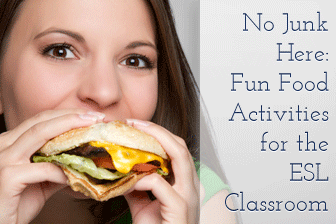School Days, School Days: Highly Effective Discussion Based Activities on School


Junk…it can mean the items you throw away during spring-cleaning. Junk can refer to what gathers at the edge of a public sewer grate. Junk can be bits and pieces of old cars and machines waiting to be repurposed for repairs. The word junk can be used to refer to so many things, so when did it come to describe the food that so many young people eat on a daily basis?
Junk food includes a large spectrum of not so nutritionally beneficial cuisines. Some people have even gone so far as to describe the four junk food groups! Most of the time, though, junk food is the casual laid back items that people tend to eat at social events or with friends. Though often they are, these social foods, though, do not have to be nutritionally empty to be enjoyable. Why not open up the junk food conversation with your ESL class and let your students weigh in their own opinions when it comes to junk food?

A Common Definition
People have many different definitions of what junk food includes. For some, it is social or casual food. For others, junk food earns its title through nutritional information. Still others define junk food by how much pleasure one takes while consuming it. Start the culinary discussion by asking your students to given their own opinions on what constitutes junk food. In small discussion groups, ask each person to explain what they understand junk food to be. What criteria does each person use to classify something as junk food? Ask each person to share what some of his favorite junk foods are with his group. Then, working together, challenge each group to articulate a definition for the phrase ‘junk food’. They can write anything they choose for the definition, but it should include input from each group member and his understanding and personal definition of junk food. Then have each group explain its definition to the rest of the class noting similarities and differences with each group’s definition.
Junk Reading
Just about every ESL student spends time in reading class, but being a proficient reader includes more than just books and magazines. Sometimes reading proficiency requires a second language speaker to read nontraditional texts, in this case nutrition labels. To familiarize your students with nutrition labels, you can copy one label or print one from the internet and walk your class through each piece of information on the label. You will want to point out each of the following specifics from the food label: serving size and servings per container, calories and calories from fat, total fat and cholesterol, sodium, carbohydrate and fiber, protein, and vitamins and minerals. You should also highlight that the label gives percentages as applied to a 2000 calorie a day diet, an appropriate number for most adults.
Now that your class has a general familiarity with nutrition labels and knows what the numbers and vocabulary mean, it is time to apply the general knowledge to junk food. Provide for your students a collection of nutrition labels for them to read in their discussion groups. If possible, plan ahead and ask your class to bring in labels from the foods they eat on a daily basis and use those, or collect several food labels on your own and copy them for your class. In your set of labels, include what are traditionally considered junk foods as well as traditionally non-junk foods. Label each of the tables with a letter (ideally A through J) and keep a record for yourself of which labels are from which foods. Then ask your groups to read the labels and decide if each of the items should be classified as junk food. To do this, your groups should use the definitions they composed in the first activity. After reading each label and comparing the food to the definition, each group should divide the labels into junk food and non-junk food. Once all the groups have finished, reveal to them what products the labels came from and discuss any surprises. Now that the groups know what products the labels are from, would they change any classifications?
Vending Creativity
Your class has discussed the definition of junk food, they have applied their reading skills to nutrition labels, and now it is time for some creativity. Start by brainstorming with your class the different locations vending machines are often located. Your list should include schools, businesses, rest stops, malls, department stores and as many other places as your class can think of. Then, if your school has vending machines, take your class on a mini fieldtrip to that vending machine to take a look at what is inside. Many vending machines hold fifty products or more, and many of those products probably fit your students’ definitions of junk food. Ask your students to take note of the products offered in the vending machine. If you want, you can ask them to write their notes down to help them remember what the machine has to offer. Then, returning to your classroom, ask each person to design the contents of his own vending machine. The diagram does not have to be detailed – a blank grid is enough. Each student should be specific, though, about the items that he or she would include in the vending machine. Encourage your students to be creative. They can include both refrigerated and nonrefrigerated items as well as products available in their local area along with those only available in their home countries. Students should keep in mind the discussions about junk food while making their designs. Some may choose to include unhealthy foods and others may choose only healthy foods. Most will probably include a combination of the two. Once each person has finished his vending machine, display the pictures along a hallway outside your classroom. Your class will then vote on their favorite vending machine. Giving each person a paper coin, send your class members one at a time to the hallway to tape their coins under the vending machine they would most likely choose. After everyone has voted, note which products are most appealing to your class.
Through these exercises, your students will increase their knowledge of good nutrition and perhaps think twice before consuming items that are bad for their health. If nothing else, you will know what snacks would be most popular at your next in class party. Have fun with these activities, and bon appetit!